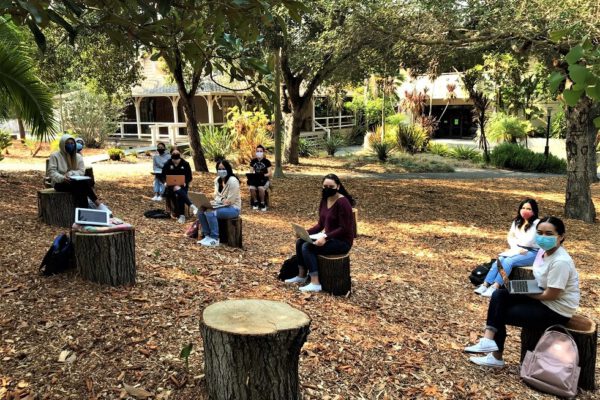By Elizabeth Hillman and John Marx
John Marx is blogging about his year in the ACE Fellows Program in a series of posts centered on the idea of “place” in American higher education leadership. Marx, professor and chair of the English Department at University of California, Davis, is spending his year working with President Elizabeth Hillman at Mills College in Oakland, California.
It’s no accident that Ruth Simmons, a leader of institutions across the varied landscape of higher education in the United States, testified in the Harvard University admissions trial this fall. She was one of the experts called upon to weigh in on Harvard’s approach to undergraduate diversity, which plaintiffs allege disadvantages Asian American applicants. Who better to explain how college works than Simmons, the current president of historically black university Prairie View A&M, the first black president of an Ivy League university at Brown University (where she was also the first female president), and a former president of Smith College, a leading liberal arts and women’s college?
In her testimony, Simmons recalled being an undergraduate at another women’s college, Wellesley, where she remembered a South African classmate offering a contrary view on the topic of apartheid. “I was forced to listen to a different opinion,” Simmons recounted. “Today I remember no one in that class, but I remember her.” Here was a powerful example of how diversity of background and opinion shapes what happens in college classrooms.
Even as she drew attention to the value of diversity, Simmons equally promoted the idea that colleges and universities have a duty to retain their individuality. Simmons defended legacy admissions, “in keeping with the tradition that we have as institutions, where there’s a strong identity alumni have with their institutions.”
Diversity is not at odds with the distinctive institutional identities that Simmons evokes. The women’s colleges at which she studied and led reveal how demographics and college identities have shifted over time. Women’s colleges such as Wellesley, Smith, and Mills have always been radical, although they have not always been inclusive.
These institutions were founded to provide educational experiences that women would not otherwise have. For instance, Bryn Mawr opened its doors in the nineteenth century with the goal of offering “women rigorous intellectual training and the chance to do to original research, a European-style program that was then available only at a few elite institutions for men.” The history of Mills College is similarly one of firsts going back to the nineteenth century. More recently, Mills was the first women’s college to offer a computer science major (1974) and the first to introduce a transgender admission policy (2014).
With initiatives like these, women’s colleges help the United States play catch up on gender equity. They provide peer support and mentoring, which makes a big difference in scholastic and workplace success. Particularly when it comes to STEM education, the research shows that undergraduate and graduate women alike are more successful when they have women as mentors and peers.
Whether you went to a women’s college or not, it’s easy to see the value of such support networks after graduation, especially given the lack of meaningful progress in gender diversity uncovered by a comprehensive Lean In/McKinsey study on the state of women in corporate America.
Women’s colleges are justifiably grabbing headlines in a year dominated by the politics of #metoo and an election cycle that saw more than 100 women win office in the U.S House of Representatives. In recent months, The Chronicle of Higher Education has discovered a “Newfound Enthusiasm for Women’s Colleges,” while Inside Higher Ed has observed “A Trump Bump in Yields at Women’s Colleges.” Globally, the education of women and girls is an imperative for human rights advocates, anti-violence crusaders, and environmental evangelists.
For all that gender equity is in their DNA, that identity is not worth as much if women’s colleges don’t also prioritize diversity. This could mean recruiting more international students, like Mount Holyoke, where nearly a third of undergraduates come from outside the United States. It could mean recruiting more intentionally in your own backyard: Mills has been enrolling more students from Oakland and can tout numbers showing 57 percent of undergraduates self-identify as students of color.
Supporting diverse student populations means taking their differences seriously, as is undoubtedly clear at any college seeking to demonstrate that inclusion and identity are not mutually exclusive.
Communication is important too. Like many of its peers, Mills works hard at broadcasting the message that diversity is welcomed and wanted. If you look at Mills on Google Maps from above, you see an island of green amidst the urban density of East Oakland. A campus of meadows and historic buildings can convey privilege and exclusion rather than openness and opportunity unless it makes a concerted effort to say otherwise.
Those messages, at Mills and many other historically exclusive campuses, embrace the diversity of the next generation of women leaders and are committed to advancing gender and racial equity. Our efforts model what the Association of American Colleges and Universities calls “inclusive excellence,” a term that demands one understand there is no excellence without diversity.
As the Harvard trial reminds all of us, getting inclusive excellence right is a matter that challenges every aspect of institutional life, from admissions practices to public relations. Gripping though the trial has been, however, we suggest you look beyond Cambridge to learn how identity and diversity work together across the landscape of higher education in the United States.
Look to women’s colleges, which occupy an institutional niche that may be central to higher education’s future. In so doing, you’ll be reminded not only that higher education is a diverse sector, but also that its traditional hierarchies don’t necessarily indicate where the big ideas are being generated.
Cover photo courtesy of Barnard College/Dorothy Hong.
Also see: Dealing With the Historical Injustice of Slavery on Today’s College Campuses
Under the leadership of President Ruth Simmons, Brown University released a landmark report in 2006 documenting the participation of some of Brown’s founders and benefactors in the 18th transatlantic slave trade and presented recommendations on how to address this troubling legacy. A decade later, Georgetown University (DC) and President John J. DeGioia followed suit, releasing a 2016 report from the university’s Working Group on Slavery, Memory, and Reconciliation. During this session at ACE2018, Simmons and DeGioia discussed how the legacy of slavery impacts the modern-day fulfillment of higher education’s mission.
If you have any questions or comments about this blog post, please contact us.


